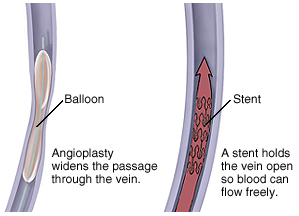Venous Angioplasty and Stenting
Venous angioplasty is a procedure done to treat vein blockages. Large veins that are narrowed or blocked can cause severe swelling and pain. Sometimes a metal mesh tube called a stent may also be placed into the vein to hold it open. This procedure is done by a specially trained doctor called an interventional radiologist. This doctor is trained and certified by the American Board of Radiology to use minimally invasive, image-guided procedures to diagnose and treat diseases. Vascular surgeons may also do this procedure.

Before your procedure
Follow any instructions you are given on how to get ready. This includes any directions you’re given for not eating or drinking before the procedure.
Tell your healthcare provider if you:
-
Are pregnant, think you may be pregnant, or are breastfeeding
-
Are allergic to X-ray dye, also called contrast medium, or any other medicines
-
Have had any recent illnesses
-
Have any health conditions
Tell your healthcare provider about all medicines you take. You may need to stop taking some or all of them before the procedure. This includes:
-
All prescription medicines
-
Herbs, vitamins, and other supplements
-
Over-the-counter medicines such as aspirin or ibuprofen
-
Illegal drugs
Have a friend or relative available to drive you home.
During your procedure
-
You'll change into a hospital gown and lie on an X-ray table. An IV (intravenous) line is put into a vein in your arm or hand. This is to give you fluids and medicines. You may be given medicine to help you relax. Medicine will be put in the skin at the insertion site to numb it.
-
A very small cut (incision) is made over the insertion site. Then a needle with a thin guide wire is put through your skin into the vein. A thin, flexible tube called a catheter is put over the guide wire into the blood vessel.
-
X-ray dye is injected into your blood vessel. This helps the veins show up clearly on X-ray images. The radiologist uses these images as a guide. They move the catheter to the narrowed or blocked part of the vein.
-
When the catheter reaches the narrowed or blocked area, the radiologist inflates a special balloon that is attached to the catheter (angioplasty). This widens the passage through the vein.
-
A stent may be put in place to hold the vein open. To do this, a catheter with a stent attached is threaded over the guide wire. The stent is opened when it reaches the narrowed area. The stent stays in the vein. The catheters and balloons are taken out.
After your procedure
-
You may stay in the hospital for a few hours or overnight.
-
Drink plenty of fluids to help flush the X-ray dye out of your body.
-
Care for the insertion site as directed.
Possible risks
All procedures have some risk. Possible risks of venous angioplasty with stenting include:
-
Bruising at the catheter insertion site
-
Damage to the vein. This includes the blockage getting worse. A blood clot may form in the area and result in chronic swelling.
-
Infection
-
Problems because of the X-ray dye. These include allergic reaction or kidney damage.
-
The vein becomes blocked again. This is called restenosis. This often happens within 6 to 18 months.
© 2000-2024 The StayWell Company, LLC. All rights reserved. This information is not intended as a substitute for professional medical care. Always follow your healthcare professional's instructions.